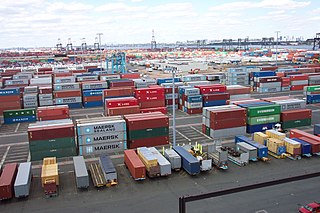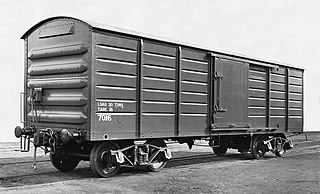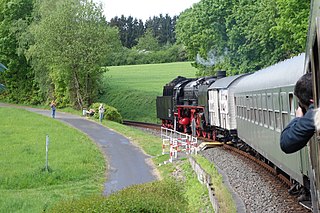
Containerization is a system of intermodal freight transport using intermodal containers. Containerization, also referred as container stuffing or container loading, is the process of unitization of cargoes in exports. Containerization is the predominant form of unitization of export cargoes today, as opposed to other systems such as the barge system or palletization. The containers have standardized dimensions. They can be loaded and unloaded, stacked, transported efficiently over long distances, and transferred from one mode of transport to another—container ships, rail transport flatcars, and semi-trailer trucks—without being opened. The handling system is mechanized so that all handling is done with cranes and special forklift trucks. All containers are numbered and tracked using computerized systems.

An intermodal container, often called a shipping container, or cargo container, (or simply “container”) is a large metal crate designed and built for intermodal freight transport, meaning these containers can be used across different modes of transport – such as from ships to trains to trucks – without unloading and reloading their cargo. Intermodal containers are primarily used to store and transport materials and products efficiently and securely in the global containerized intermodal freight transport system, but smaller numbers are in regional use as well. It is like a boxcar that does not have wheels. Based on size alone, up to 95% of intermodal containers comply with ISO standards, and can officially be called ISO containers. These containers are known by many names: freight container, sea container, ocean container, container van or sea van, sea can or C can, or MILVAN, or SEAVAN. The term CONEX (Box) is a technically incorrect carry-over usage of the name of an important predecessor of the ISO containers: the much smaller steel CONEX boxes used by the U.S. Army.

A boxcar is the North American (AAR) and South Australian Railways term for a railroad car that is enclosed and generally used to carry freight. The boxcar, while not the simplest freight car design, is considered one of the most versatile since it can carry most loads. Boxcars have side sliding doors of varying size and operation, and some include end doors and adjustable bulkheads to load very large items.

Intermodal freight transport involves the transportation of freight in an intermodal container or vehicle, using multiple modes of transportation, without any handling of the freight itself when changing modes. The method reduces cargo handling, and so improves security, reduces damage and loss, and allows freight to be transported faster. Reduced costs over road trucking is the key benefit for inter-continental use. This may be offset by reduced timings for road transport over shorter distances.

A loading gauge is a diagram or physical structure that defines the maximum height and width dimensions in railway vehicles and their loads. Their purpose is to ensure that rail vehicles can pass safely through tunnels and under bridges, and keep clear of platforms, trackside buildings and structures. Classification systems vary between different countries, and loading gauges may vary across a network, even if the track gauge is uniform.

A unit load device (ULD) is a container used to load luggage, freight, and mail on wide-body aircraft and specific narrow-body aircraft. It allows preloading of cargo, provided the containerised load fits in the aircraft, enabling efficient planning of aircraft weight and balance and reduced labour and time in loading aircraft holds compared with 'bulk-loading' single items of cargo or luggage by hand. Each ULD has its own packing list or manifest so that its contents can be tracked. A loaded aircraft cargo pallet secured with a cargo net also forms a ULD, but its load must be gauged for size in addition to being weighed to ensure aircraft door and hold clearances.

A flatcar (US) is a piece of rolling stock that consists of an open, flat deck mounted on trucks (US) or bogies (UK) at each end. Occasionally, flat cars designed to carry extra heavy or extra large loads are mounted on a pair of bogies under each end. The deck of the car can be wood or steel, and the sides of the deck can include pockets for stakes or tie-down points to secure loads. Flatcars designed for carrying machinery have sliding chain assemblies recessed in the deck.

The Finnish railway network consists of a total track length of 9,216 km (5,727 mi). The railways are built with a broad 1,524 mm track gauge, of which 3,249 km (2,019 mi) is electrified. Passenger trains are operated by the state-owned enterprise VR that runs services on 7,225 km (4,489 mi) of track. These services cover all major cities and many rural areas, though the coverage is less than the coverage provided by the bus services. Most passenger train services originate or terminate at Helsinki Central railway station, and a large proportion of the passenger rail network radiates out of Helsinki. VR also operates freight services. Maintenance and construction of the railway network itself is the responsibility of the Finnish Rail Administration, which is a part of the Finnish Transport Agency. The network consists of six areal centres, that manage the use and maintenance of the routes in co-operation. Cargo yards and large stations may have their own signalling systems.

Rail freight transport is the use of railways and trains to transport cargo as opposed to human passengers.

A structure gauge, also called the minimum structure outline, is a diagram or physical structure that sets limits to the extent that bridges, tunnels and other infrastructure can encroach on rail vehicles. It specifies the height and width of station platforms, tunnels and bridges, and the width of the doors that allow access to a warehouse from a rail siding. Specifications may include the minimum distance from rail vehicles to railway platforms, buildings, lineside electrical equipment cabinets, signalling equipment, third rails or supports for overhead lines.

Railways with a railway track gauge of 5 ft first appeared in the United Kingdom and the United States. This gauge became commonly known as "Russian gauge", because the government of the Russian Empire chose it in 1843. Former areas and states of the Empire have inherited this standard. However in 1970, Soviet Railways re-defined the gauge as 1,520 mm.
The African Union of Railways is an organisation under the auspices of the new African Union dealing with railways. It is similar to the International Union of Railways (UIC).

In road transport, an oversize load is a load that exceeds the standard or ordinary legal size and/or weight limits for a truck to convey on a specified portion of road, highway, or other transport infrastructure, such as air freight or water freight. In Europe, it may be referred to as special transport or heavy and oversized transportation. There may also be load-per-axle limits. However, a load that exceeds the per-axle limits but not the overall weight limits is considered overweight. Examples of oversize/overweight loads include construction machines, pre-built homes, containers, and construction elements.

Rail transport in Cameroon is primarily operated by Camrail, a subsidiary of Bolloré Africa Logistics.

Rail transport in Europe has diverse technological standards, operating concepts, and infrastructures. Common features are the widespread use of standard-gauge rail, high operational safety and a high share of electrification. Electrified railway networks operate at many different voltages, both AC and DC, varying from 750 to 25,000 volts, and signaling systems vary from country to country, complicating cross-border traffic.

A well car, also known as a double-stack car, is a type of railroad car specially designed to carry intermodal containers used in intermodal freight transport. The "well" is a depressed section that sits close to the rails between the wheel trucks of the car, allowing a container to be carried lower than on a traditional flatcar. This makes it possible to carry a stack of two containers per unit on railway lines wherever the structure gauge assures sufficient clearance.

Trailer on flatcar, also known as TOFC or piggyback, is the practice of carrying semi-trailers on railroad flatcars. TOFC allows for shippers to move truckloads long distances more cheaply than can be done by having each trailer towed by a truck, since one train can carry more than 100 trailers at once. The trailers will be moved by truck from their origin to an intermodal facility, where they will then be loaded onto a train, typically by a rubber tired gantry crane, for the bulk of their journey. Alternatively, trailers may be driven onto the flatcars via ramps by a terminal tractor. Near the destination, the trailers are unloaded at another facility and brought to their final destination by a tractor unit.

Double-stack rail transport is a form of intermodal freight transport in which railroad cars carry two layers of intermodal containers. Invented in the United States in 1984, it is now being used for nearly seventy percent of United States intermodal shipments. Using double stack technology, a freight train of a given length can carry roughly twice as many containers, sharply reducing transport costs per container. On United States railroads special well cars are used for double-stack shipment to reduce the needed vertical clearance and to lower the center of gravity of a loaded car. In addition, the well car design reduces damage in transit and provides greater cargo security by cradling the lower containers so their doors cannot be opened. A succession of larger container sizes have been introduced to further increase shipping productivity in the United States.

A roller container is a container type that can be carried by trucks to be pushed to ground level by help of a hook and level arm with the container possibly sliding on steel roller wheels.

A pocket wagon is a freight wagon that has been specially designed for the transport of truck semi-trailers. This wagon belongs to the group of flat wagons in special design with bogies and is used in combined transport (CT). The name of these freight wagons comes from the fact that between the narrow longitudinal girders on the outside and also lengthways between the bogies, the so-called pockets are located, in which the wheels of the semi-trailers are particularly low. For flexible use in CT, pocket wagons have hinged latches with ISO spigots on the solebar, so that containers and swap bodies up to 45 ft can be accommodated. As a flat wagon, it bears the UIC generic letter S and, since it is intended for the transport of road vehicles on one level, the code letter d. Since it is also possible to transport containers in a pocket wagon, it bears the UIC generic mark Sdgs. In this context, the code letter g stands for "containers up to 60 feet" and the lower case s for the permitted speed of up to 100 km/h (62 mph). The wagons have a yellow triangle with a black P on the long side. The first pocket wagons were built in Germany as early as 1972 and further developed according to requirements.



















